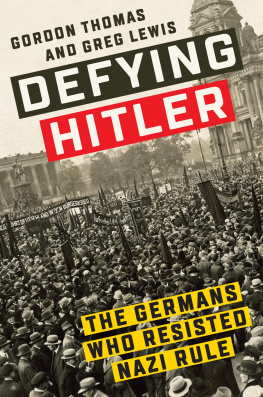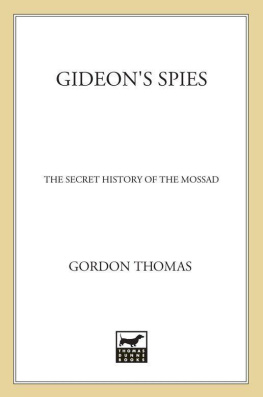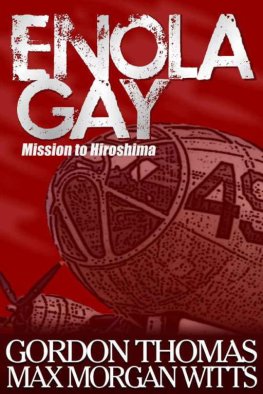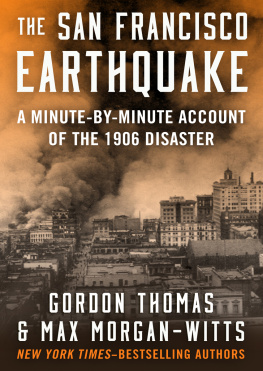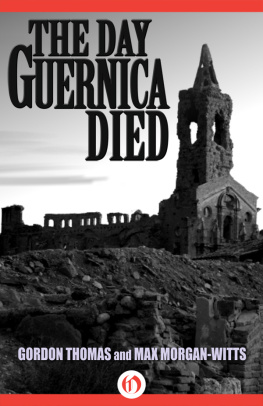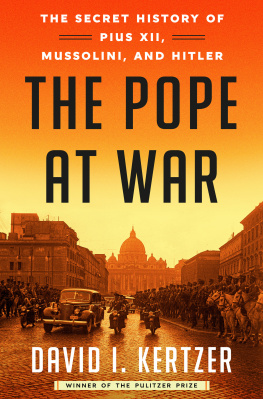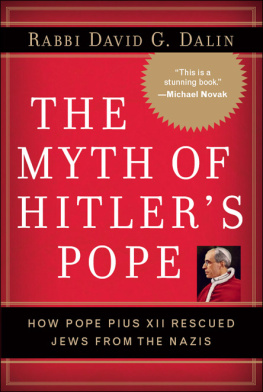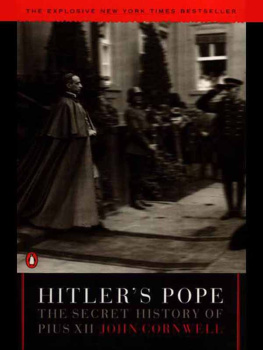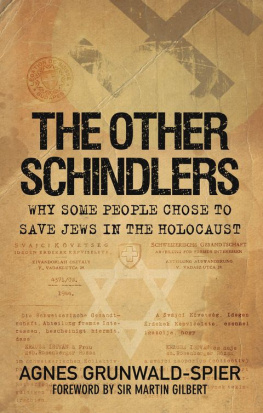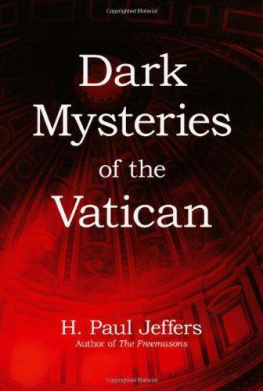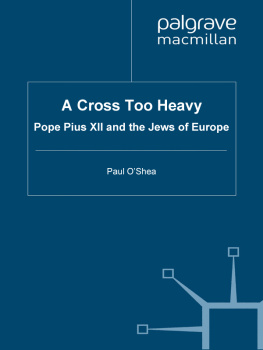
The author and publisher have provided this e-book to you for your personal use only. You may not make this e-book publicly available in any way. Copyright infringement is against the law. If you believe the copy of this e-book you are reading infringes on the authors copyright, please notify the publisher at: us.macmillanusa.com/piracy.
For Edith,
a full partner in all respects. Her intelligence, determination, and high standards improved this book in so many ways.
CONTENTS
FORETHOUGHTS
No crime in history has so deeply shocked mankind as did Hitlers Holocaust in World War Two. More than six million peoplemostly Jews but not exclusivelywere murdered and countless more still carry to this day the scars of their suffering. The horror inflicted has led to claims there are no new dimensions to explore of this unprecedented genocide. The truth is otherwise. Anti-Semitism remains the most odious of scourges, proof that little has changed from what Hitler wrote in a letter in 1919 to a comrade he had served with in the trenches of the Great War.
Anti-Semitism on purely emotional grounds will find its final expression in the form of pogroms. However, rational anti-Semitism must lead to a carefully planned legal curbing and eradication of Jewish privileges, though its final, unalterable objective must be the removal of the Jews altogether.
In an interview in 1922 with Josef Hell for the Institute fr Zeitgeschichte Hitler was more specific.
If I am ever really in power, the destruction of the Jews will be my first and most important job. As soon as I have power, I shall have gallows after gallows erected, for example, in Munich on the Marienplatzas many of them as traffic allows. Then the Jews will be hanged one after another, and they will stay hanging as long as hygienically possible. As soon as they are untied, then the next group will follow and that will continue until the last Jew in Munich is exterminated. Exactly the same procedure will be followed in other cities until Germany is cleansed of the last Jew.
Those words have formed part of a campaign against the World War Two leader of the Roman Catholic Church, Pope Pius XII. He is accused of failing to condemn Hitler for the bigotry and racial hatred with which the fhrer led Germany, because the pontiff feared an even greater enemy of the church: Soviet Communism.
That fear, say his critics, was fuelled by his own anti-Semitism. They have reduced this hateful allegation to a few questions: What did Pius XII do in the darkest days of World War Two to stop the horrors committed against the Jews? Why had he not excommunicated Hitler and all Nazis from the church, the greatest punishment he could have inflicted? Why had he never mentioned the word Jews in his wartime speeches? Had all those prewar years as a nuncio, a Vatican ambassador, in Germany made him a Nazi sympathizer? The questions have fed the slanders and prejudices which no other pope has faced. This torrent of accusations are today at the core of the opposition to Pius XII being created a saint of the Catholic Church. His critics insisted his silence over the Final Solution during the war barred him from beatification.
Thus the truth is misrepresented and buried in falsehood, leaving the historical record distorted.
Facts were cast aside, research into primary sources dismissed, and arguments about the need for balanced interpretations ignored. Pius had become another casualty of truth.
* * *
While researching my last book, Operation Exodus, which deals with an aspect of the Holocaust, I came across a letter written in 1943 by Chaim Weizmann, who would become Israels first president. It offered thanks for the support the Holy See was giving to lend its powerful help whenever it can to mitigate the fate of my coreligionists.
Three years before Weizmann offered his thanks, Albert Einstein had told Time magazine in its 1940 Christmas edition that only the church stood squarely across the path of Hitlers campaign of suppressing the truth. I have never had any special interest in the church before, but now I feel a great affection and admiration because the church alone has had the courage and persistence to stand for intellectual truth and moral freedom.
From time to time items came my way with similar views about Pius XII. Monsignor John Magee, who was the English-language private secretary to Pope John Paul, spent one dinner with me dissecting what he called the wretched calumnies against Pius. Father Lambert Greenan, an acerbic Irish Dominican priest, went back through his files at LOsservatore Romano where he was one of the editors, to provide evidence of Piuss condemnation of Kristallnacht in 1938 and from his time as nuncio in Germany.
Of the forty-four speeches he made as a nuncio, forty denounced aspects of the emerging Nazi ideology. In 1935 he wrote an open letter to the bishop of Cologne describing Hitler as a false prophet of Lucifer. Two years later at Notre Dame in Paris he said Germany was being led astray into an ideology of race. Hitler ordered the Nazi press to brand him as a Jew lover in the Vatican.
* * *
I began doing more detailed research which included tracking down new witnesses of a terrible moment in the twentieth century. Theirs is a story of fear, of an experience that still traumatizes them. Many have not spoken before, yet they gave their time to recall a story which encompasses a period somewhere between recent history and fading memory. As well as all the usual research tools for any serious investigationofficial records, memoranda, a wide variety of published and private material, diaries, letters, logs, and reportsthe main resource, as with my previous books, has been people. Many of the eyewitnesses for this book had not been interviewed before and often felt they could now finally speak because a decent interval had elapsed. Sometimes there can be no simple explanation for the way people behaved. But the one certainty is that theirs is the truth of honest recall.
It also became clear that the most effective way to tell the story was to focus on the relationship between the Vatican and its neighbors, the Jews of the ghetto in Rome. In all the arguments which have raged over the role of Pope Pius during World War Two little space has been given to the people living along the banks of the Tiber. Yet they not only represent the six million victims of the Holocaust but also symbolize its survivors.
As well as those who sheltered with them, the Allied soldiers who had escaped from Italian prisoner-of-war camps, those who helped them, and Pope Pius and his Vatican priests and nuns, this book is ultimately the story of the people of the Rome ghetto. Theirs is a microcosm of a cruel and unjust time.
While the tone is, of course, my own, since a writers voice is not interchangeable, I have tried to remain faithful to the voices which have long waited to be heard.
PART I
THE POWER AND THE GLORY
A WAY TO DIE
On that cheerless winter morning, February 10, 1939, Eugenio Maria Guiseppe Pacelli stood in the bedroom doorway, watching what was happening around the brass-framed bed. The two middle-aged nuns went about their work with the gentle movements he expected. Dealing with the dead was something years of experience had given them. For Pacelli dying was a guarantee of afterlife. Long ago he had learned that promise from his mother, Virginia, a pious daughter of the Roman Catholic Church.
Her son was His Eminence, the cardinal secretary of state of the Holy See, the second most powerful figure in the church. An hour ago, following the death of the old man in the bed, Pope Pius XI, Pacelli had become the most important figure in the entire Catholic world. He was now the Camerlengo, a position which combined the role of the Vatican treasurer and chamberlain of the Holy See. He would be responsible for organizing the funeral of Pope Pius XI and the conclave to elect a new pope.
Next page

